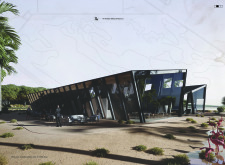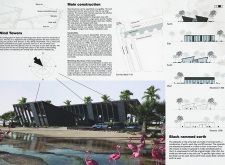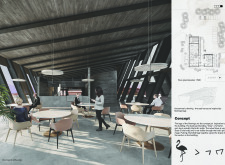5 key facts about this project
The Al Wathba Wetland Reserve combines natural elements with human design, fitting within the ecological landscape of Abu Dhabi. The center enhances the visitor's experience while focusing on sustainability and environmental considerations. The building integrates traditional cooling methods with modern design features, creating a strong link to its surrounding area.
Wind Towers
Wind towers serve as a central feature of the design, employing natural cooling techniques to maintain a comfortable indoor climate. These structures draw warm air upwards through openings that can adjust automatically to the temperature. As the air moves downward, it passes through mist jets that cool it before it enters the main building. This approach minimizes the need for mechanical air conditioning, which aligns well with sustainable practices.
Structural Framework
The visitor center is primarily constructed of steel, allowing for quick assembly and vast open spaces. The lightweight nature of steel also means smaller foundations are needed, which reduces the building's overall impact on the environment. In conjunction with steel, rammed earth is used to create an entry facade that connects the structure with the local landscape. This combination of materials reflects the surrounding geography while providing the durability required for a public building.
Sustainability
Sustainability is a key aspect of the design, as shown in methods that support energy efficiency and responsible resource use. The building features high-insulated glass, which helps to manage temperature and save energy. Interior blinds are strategically placed to control sunlight, further reducing cooling costs. The project encourages the recycling of materials by allowing for easy disassembly and reuse, which aligns with modern principles of sustainability.
Conceptual Influences
The shape of the center is inspired by the anatomy of the flamingo, a bird native to the wetlands. The structure mimics the elegant posture of the flamingo, particularly its backward-bending "knee." This unique design enhances visual interest while also telling a story about the local environment. Visitors can see how the building reflects the grace of the flamingo, drawing a direct connection between architecture and nature.
The layout encourages exploration of the wetlands, with clear sightlines and pathways that promote interaction with the ecological surroundings. This design choice results in an experience that connects visitors to the landscape, highlighting the importance of both nature and thoughtful architectural design.






















































